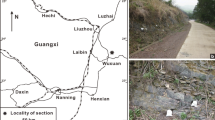Abstract
Conodonts found for the first time in eastern Iran (the Bage-Vang section) are characterized. Beds with conodonts also yield fusulinids that is suitable for refining correlation of conodont and fusulinid zonations. Stratigraphic ranges of different conodont species in the Bage-Vang section are correlated with those in the Luodian section (South China), where conodonts are also accompanied by fusulinids. As a result, some previous inferences concerning position of the Guadalupian Series base in the Tethyan sections are refined.
Similar content being viewed by others
References
F. N. Behnken, B. R. Wardlaw, and L. N. Stout, “Conodont Biostratigraphy of the Permian Meade Peak Phosphatic Shale Member, Phosphoria Formation, Southeastern Idaho,” Contrib. Univ. Wyoming 24(2), 9–190 (1986).
D. L. Clark and Wang Cheng-Yuan, “Permian Neogondolellids from South China: Significance for Evolution of the Serrata and Carinata Groups in North America,” J. Paleontology 62(1), 132–138 (1988).
M. Gullo and H. Kozur, “Conodonts from the Pelagic Deep-Water Permian of Central Western Sicily (Italy),” Neues Jahrb. N. Jb. Geol. Paläontol, Abh. 184(2), 203–234 (1992).
Ch. M. Henderson, Jin Yugan, B. R. Wardlaw, and Mei Shilong, “Conodont Succession in Nashui/Luodian Section, South China, and Its Significance in Correlation of Cisuralian and Guadalupian Conodont and Fusulinacean Zones,” in XIV ICCP. Pander Soc. Canad. Paleontol. Conf. Programme with Abstracts, 1999, p. 67.
K. I. Ishii, Y. Okimura, and K. Nakazawa, “On the Genus Colaniella and Its Biostratigraphic Significance,” J. Geosciences, Osaka City University 19(6), 107–138 (1975).
C. Jenny-Deshusses and A. Baud, “Colaniella, foraminifère index du Permien tardif tethysien: propositions pour une taxonomie simplifiée, retardition géographique et environnements,” Ecl. Geol. Helveiae 82(3), 869–901 (1989).
G. V. Kotlyar, Yu. D. Zakharov, B. V. Kochirkevich, et al., Late Permian Stage of the Organic World Evolution. Dzhulfian and Dorashamian Stages of the USSR (Leningrad, Nauka, 1983) [in Russian].
H. W. Kozur, “Gullodus n. gen. — a New Conodont Genus and Remarks to the Pelagic Permian and Triassic of Western Sicily,” Jahrb. Geol. B.-A. 136(1), 77–87 (1993).
H. W. Kozur, “New Stratigraphic Results in the Permian of the Sosio Valley Area, Western Sicily, Italy,” in Proceedings of the XIII International Congress on the Carboniferous and Permian (Inst. Geol., 1997), Vol. 157, pp. 145–157.
H. W. Kozur, “The Permian Conodont Biochronology. Progress and Problems,” Proc. Royal R. Soc. of Victoria. Permian of Eastern Tethys: Biostratigraphy, Palaeogeography, and Resources 110(1, 2), 197–220 (1998).
H. W. Kozur, V. I. Davydov, and G. V. Kotlyar, “Preliminary Report on the Permian Conodont Fauna of Darvas and SE Pamir and Its Importance for the Permian Time Scale,” Permophyles, No. 24, 13–15 (1994).
H. W. Kozur and V. I. Davydov, “The Importance of the Permian of the Sosio Valley (Western Sicily, Italy) for Guadalupian Stratigraphy. 1996,” in Abstracts and Proceedings of the Second International Guadalupian Symposium, Guadalupian II, Alpine, Texas, April 10–13, 1996 (Washington, 1996), pp. 11–15.
H. W. Kozur and H. Mostler, “Guadalupian (Middle Permian) Conodonts of Sponge-Bearing Limestones from the Margins of the Delaware Basin, West Texas,” Geol. Croat. 48(2), 107–128 (1995).
H. W. Kozur, B. R. Wardlaw, A. Baud, et al., “The Guadalupian Smooth Mesogondolella Faunas and Their Possible Correlation with the International Permian Scale,” Permophyles, No. 38, 15–21 (2001).
T. B. Leonova and V. Yu. Dmitriev, Early Permian Ammonoids of Southeastern Pamirs (Nauka, Moscow, 1989) [in Russian].
E. Ja. Leven, Stratigraphy and Fusulinids of Permian Deposits of Pamirs (Nauka, Moscow, 1967) [in Russian].
E. Ja. Leven, “On the Possibility of Using the Global Stage Scale of the Permian within the Tethys,” Stratigr. Geol. Korrelyatsiya 9(2), 15–29 (2001) [Stratigr. Geol. Correlation 9 (2), 118 (2001)].
E. Ja. Leven and M. H. Vaziri, “Carboniferous-Permian Stratigraphy and Fusulinids of Eastern Iran. The Permian in the Bage-Vang Section (Shirgesht Area),” Riv. Ital. Paleontol. Stratigr. 110(2), 441–465 (2004).
E. Ja. Leven and M. F. Bogoslovskaya, “The Roadian Stage of the Permian and Problems of the Global Correlation,” Stratigr. Geol. Korrelyatsiya 14(2), 67–78 (2006) [Stratigr. Geol. Correlation 14 (2), 164–173 (2006)].
E. Ja. Leven, V. I. Davydov, and M. N. Gorgij, “Pennsylvanian Stratigraphy and Fusulinids of Central and Eastern Iran,” Palaeontologia Electronica, 9(1), 1–36 (2006). 10 MB; http://palaeo-electronica.org/paleo/2006_1/iran/issue1_06.htm.
Sh. Mei and Ch. M. Henderson, “Evolution of Permian Conodont Provincialism and Its Significance in Global Correlation and Paleoclimate Implication,” Palaeogeogr., Palaeoclimatol., Palaecol. 170, 237–260 (2001).
A. K. Miller and W. M. Furnish, “Permian Ammonoids from Tunisia,” J. Paleontol. 31(4), 705–712 (1957).
H. Partoazar, “Permian Deposits in Iran. Treatise on the Geology of Iran,” Rep. Geol. Surv. Iran, No. 22, 1–340 (1995).
A. N. Reimers, Conodonts of the Lower Permian in the Urals, Caspian Region, and Pamirs (GEOS, Moscow, 1999) [in Russian].
A. Ruttner, M. Nabavi, and J. Hajian, “Geology of the Shirgesht Area (Tabas Area, East Iran),” Rep. Geol. Surv. Iran, No. Rep. 4, 4–133 (1968).
J. J. Stöcklin, “Stratigraphic Lexicon of Iran. Part 1: Central, North and East Iran,” Rep. Geol. Surv. Iran, No. Rep. 18, 1–338 (1971).
J. J. Stöcklin, J. Eftekhar-Nezhad, and A. Hushmandzadeh, “Geology of the Shotori Range (Tabas Area, East Iran),” Rep. Geol. Surv. Iran, No. Rep. 3, 1–69 (1965).
B. R. Wardlaw and J. W. Collinson, “Conodont Paleoecology of the Permian Phosphoria Formation and Related Rocks of Wyoming and Adjacent Areas,” Spec. Pap. Geol. Surv. of America. No. Special Paper 196, 263–281 (1984).
Author information
Authors and Affiliations
Additional information
Original Russian Text © E.Ja. Leven, A.N. Reimers, H.W. Kozur, 2007, published in Stratigrafiya. Geologicheskaya Korrelyatsiya, 2007, Vol. 15, No. 1, pp. 63–72.
Rights and permissions
About this article
Cite this article
Leven, E.J., Reimers, A.N. & Kozur, H.W. First finds of Permian conodonts in eastern Iran and once again on the Guadalupian series base in Permian sections of the Tethyan realm. Stratigr. Geol. Correl. 15, 57–66 (2007). https://doi.org/10.1134/S0869593807010054
Received:
Issue Date:
DOI: https://doi.org/10.1134/S0869593807010054



